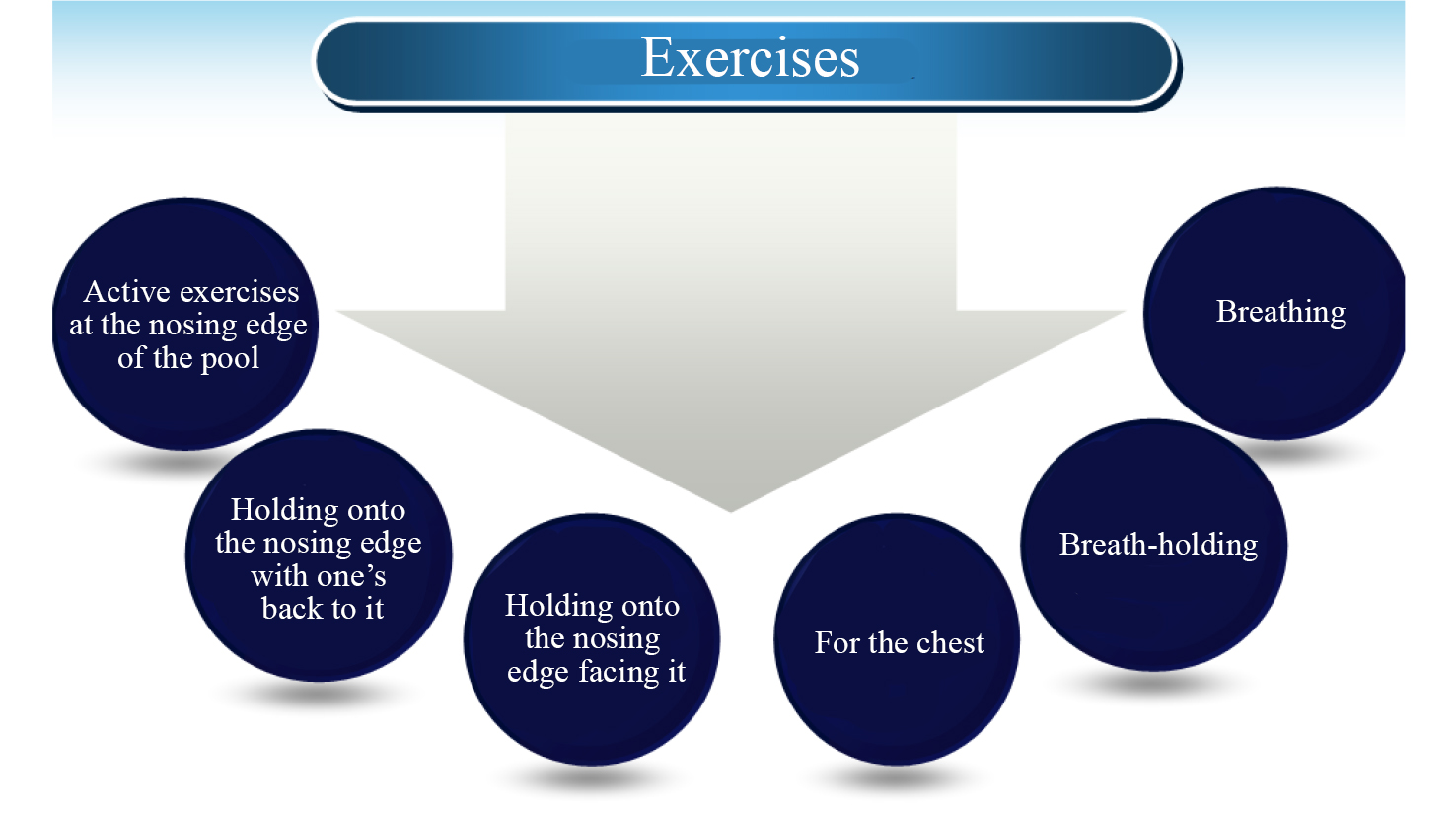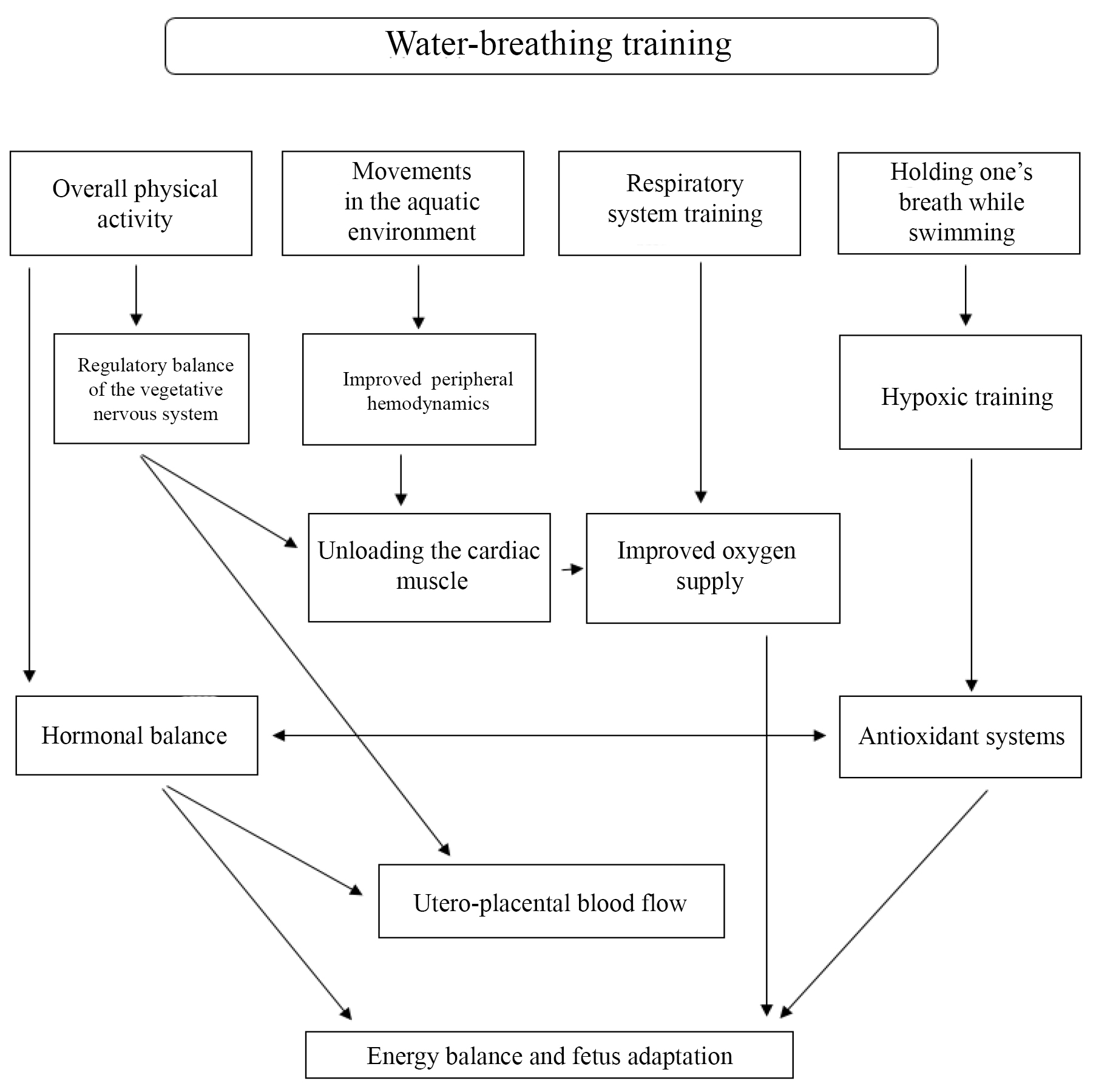Influence of water-breathing training on physiological adaptation of vegetovascular system in pregnant women
Фотографии:
ˑ:
Postgraduate student A.A. Ber1
Ph.D., Associate Professor L.M. Ber2Dr.Med, Professor L.V. Kapilevich1
1National Research Tomsk State University, Tomsk
2National Research Tomsk Polytechnic University, Tomsk
Keywords: pregnancy, adaptation, physical activity, hemodynamics, breathing, utero-placental blood flow, hormones.
Introduction. The issue of reproductive health care is currently becoming particularly important. A decline in the health of pregnant women is being noted. In Russia, disease during pregnancy is still the main cause of complications during childbirth, which then has a negative impact on the health of mother and baby. Almost 50% of pregnancy cases are associated with various types of pathology [3].
During pregnancy, an increased load on the cardiovascular system causes physiologically reversible, but quite pronounced hemodynamic changes [2]. Improvement of the load on the heart is associated with increased metabolism aimed at meeting the needs of the fetus, an increase in the blood flow and the appearance of an additional placental circulatory system with the ever-increasing body weight of the pregnant woman. Cardiac output increase is the most important hemodynamic change during pregnancy [2]. The changes occurring in the respiratory system during pregnancy are of adaptive nature since oxygen demand considerably increases during this period [5, 6].
In connection with the above it is of particular importance to develop preventive measures that enhance the adaptive capacity of pregnant women, contribute to reduction in perinatal morbidity and CNS effects in their children [1, 4, 7].
The purpose of the research was to study the characteristics of the physiological adaptation of the vegetative-vascular system in pregnant women influenced by water-breathing training.
Research methods and organization. Pregnant women aged 21-35 years were examined, gestational age being 10-39 weeks. The main group (n=135) was formed of women attending water-breathing sessions at the health and wellness center “Healthy mother – healthy baby”. The control group (n=165) was formed of women who did not attend the water-breathing sessions and were not engaged in physical activity.
All the women performed breath-holding pulmonary function tests (Stange-Hench tests). Cardio rhythmographic studies, rheovasography of lower limbs and respiratory function studies were carried out using the diagnostic system “Valenta” by the Neo Company. Hormones content in the serum was determined by enzyme-linked immunosorbent assay (ELISA). Malondialdehyde (MDA) was detected using the method of color reaction with thiobarbituric acid. The mass concentration of vitamin E in the blood serum was detected by means of the biofluid analyzer FLUORAT-02 ABFL. Utero-placental blood flow status was determined using the Philips HD 11 XE device with a two-dimensional scan mode, color Doppler and pulsed Doppler sonography. The data were mathematically processed using STATISTICA 17, Microsoft Excel software.
The women did breathing exercises (Figure 1) 3-4 times daily throughout the gestational period, and twice a week – in combination with dynamic aqua gymnastics under the supervision of a trainer-instructor. Adding aqua gymnastics exercises contributes to breath-hold while inhaling and exhaling under water, enhances metabolic processes in the body of the mother and fetus and the absorption of oxygen by the fetus, thus mobilizing functional reserves.
Results and discussion. Water-breathing training helps optimize the regulatory balance and raise the level of physiological adaptation. We were able to identify the main elements of this process that are presented in Figure 2.
There are four major factors of water-breathing training inducing adaptive changes in the body of a pregnant woman.
First of all, it is an increase in total physical activity which helps normalize the balance of the sympathetic and parasympathetic divisions of the autonomic nervous system.
Adaptive capacity of pregnant women considerably increased on the background of water-breathing training: the proportion of the maladaptive type did not exceed 1 %, while it reached 35 % in the control group. Increase of adaptive capacity is accompanied by a decrease in the tone of the sympathetic division (decrease of the tension index and the mode amplitude) and an increase in the parasympathetic one (increase of the power of fast and slow waves in the cardio interval recording spectrum).
We also observed hormonal balance improvement under the influence of physical activity, which also contributes to the activity of antioxidant systems.
Increased values of thyroid hormones, cortisol and insulin in women involved in aqua gymnastics by the third trimester of pregnancy are more pronounced than in the control group. At the same time a decrease in the concentration of malondialdehyde and an increase in the concentration of vitamin E are observed, which indicates the activation of antioxidant defense systems.
The second important factor of the water-breathing training is physical exercises done in the water. Performing particular exercises in water one can expose various body parts – legs, arms, abs, and buttocks – to dosed loads. Water exercises facilitate the blood flow to the heart, which is especially important due to the increased volume of circulating blood and extra load on the cardiac muscle. Under the influence of the water-breathing training pregnant women experience an increase of the rheographic index, decreased tone of arterioles of medium and small caliber as well as reduced dicrotic and diastolic indices (decreased venous outflow) which generally indicates balanced peripheral blood flow.
The water-breathing training increases the functionality of the respiratory system, which is manifested in the increase of forced vital capacity, peak expiratory flow rates as well as increase in the inspiratory reserve volume. Holding one’s breath while swimming is a hypoxic training component which also activates antioxidant systems.
Improvement of the functioning of the circulatory and respiratory systems as a result contributes to improvement of oxygen supply to tissues of both a pregnant woman and a fetus.
Normalization of the regulatory balance of the central nervous system and the hormonal system contributes to the normalization of the utero-placental blood flow, which is manifested in the reduced resistance index, pulse index and systolic-diastolic ratio. The effect is greater on the part of the uterine arteries.
This factor, combined with improved supply of oxygen to the tissues and activation of antioxidant defense systems, provides improved energy balance and, consequently, contributes to the adaptation of the fetus.
Conclusion. The obtained results reveal a number of essential physiological laws that underlie adaptation of the vegetative-vascular system of the body of women to the conditions of pregnancy and the impact of physical activity and breathing exercises on this process.

Figure 1. Water-breathing training for pregnant women

Figure 2. Diagram of adaptive changes in the body of a pregnant woman under the influence of water-breathing training
References
- Ber, A.A. Povyshenie fizicheskoy aktivnosti beremennykh zhenshchin s ispol'zovaniem akvagimnastiki i dykhatel'nykh uprazhneniy (Increasing amount of physical activity of pregnant women using aqua-gymnastics and breathing exercises) / A.A. Ber // Vestnik Tomskogo gosudarstvennogo universiteta. – 2012. – № 355. – P. 133–135.
- Ber, A.A. Vliyanie zanyatiy akvagimnastikoy na sostoyanie sistemy krovoobrashcheniya beremennykh (Effect of aqua-gymnastics classes on state of circulatory system of pregnant women) / A.A. Ber, K.S. Matveeta, L.V. Kapilevich // Vestnik Tomskogo gosudarstvennogo universiteta. – 2014. – № 378. – P. 191–193.
- Volodin, N.N. Metod perinatal'naya meditsina: problemy, puti i usloviya resheniya (Perinatal Medicine method: problems, ways and conditions of solution) / N.N. Volodin // Pediatriya. – 2004. – № 5. – 222 P.
- Krivonogova, T.S. Kompleksny podkhod k ozdorovleniyu beremennykh zhenshchin (Integrated approach to improvement of health of pregnant women) / T.S. Krivonogova, I.D. Evtushenko. – Tomsk: Tomsk State Univ. of Control systems and Radioelectronics. – 2008. – 122 P.
- Savchenkov, Yu.I. Emotsii, beremennost' i potomstvo (Emotions, pregnancy and offspring) / Yu.I. Savchenkov, V.A. Kovalevskiy // Akush. i ginekol. – 1984. – № 10. – P. 12–15.
- Yurasova, E.A. Norma beremennosti: osnovnye izmeneniya v organizme zhenshchiny pri beremennosti (Pregnancy norm: major changes in woman's body during pregnancy) / E.A. Yurasova, T.N. Vlasova. – Khabarovsk: Far Eastern State Med. Un-ty, 2005. – 63 P.
- Bauer, P.W., Broman, C.L., Pivarnik, J.M. Exercise and pregnancy knowledge among healthcare providers // J. Womens Health (Larchmt). – 2010. – P.335-341.
Corresponding author: kapil@yandex.ru




